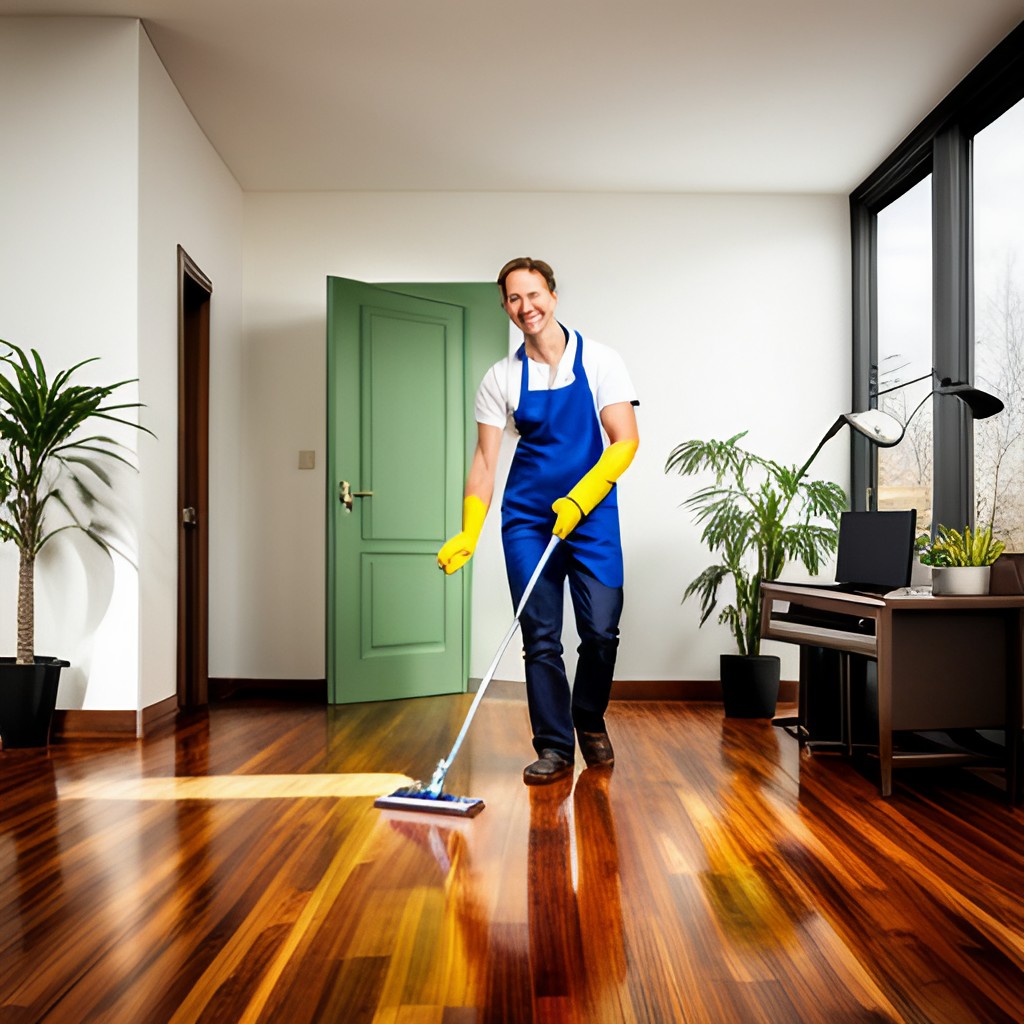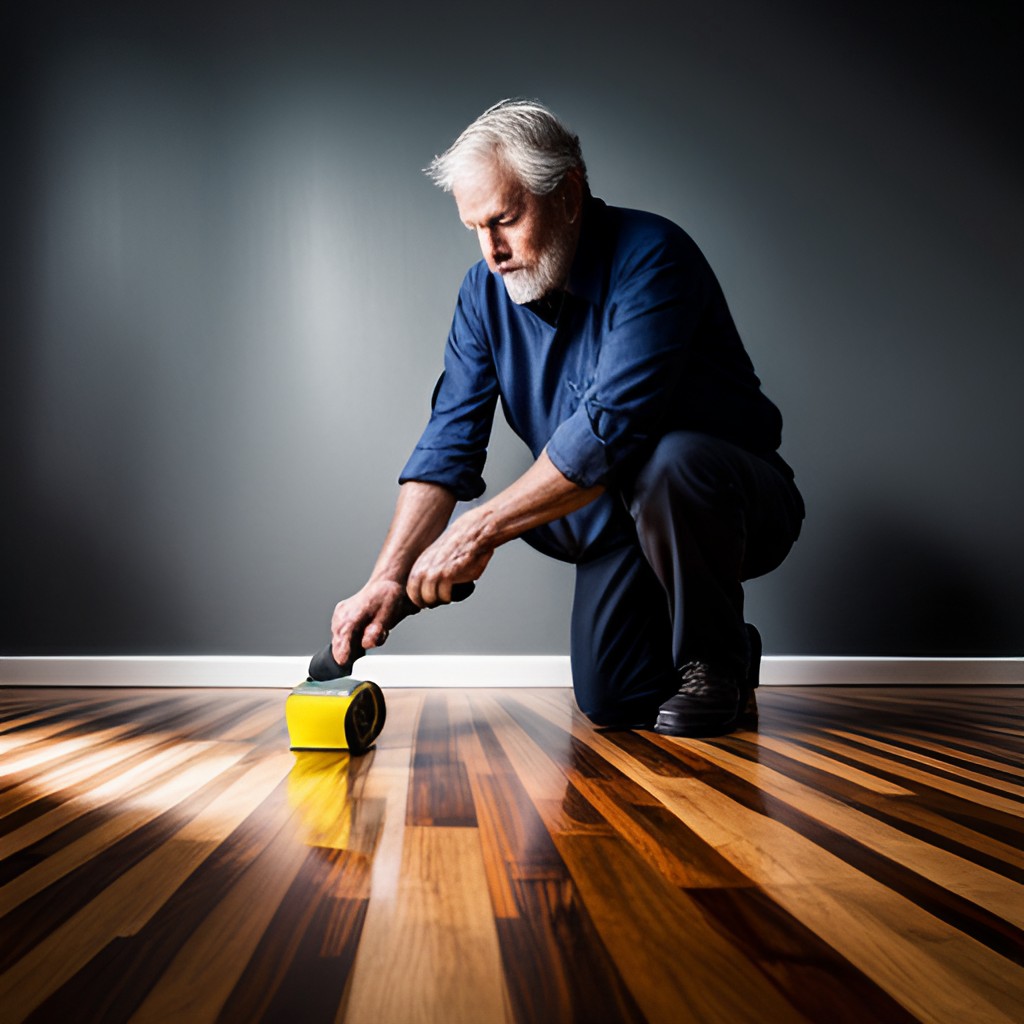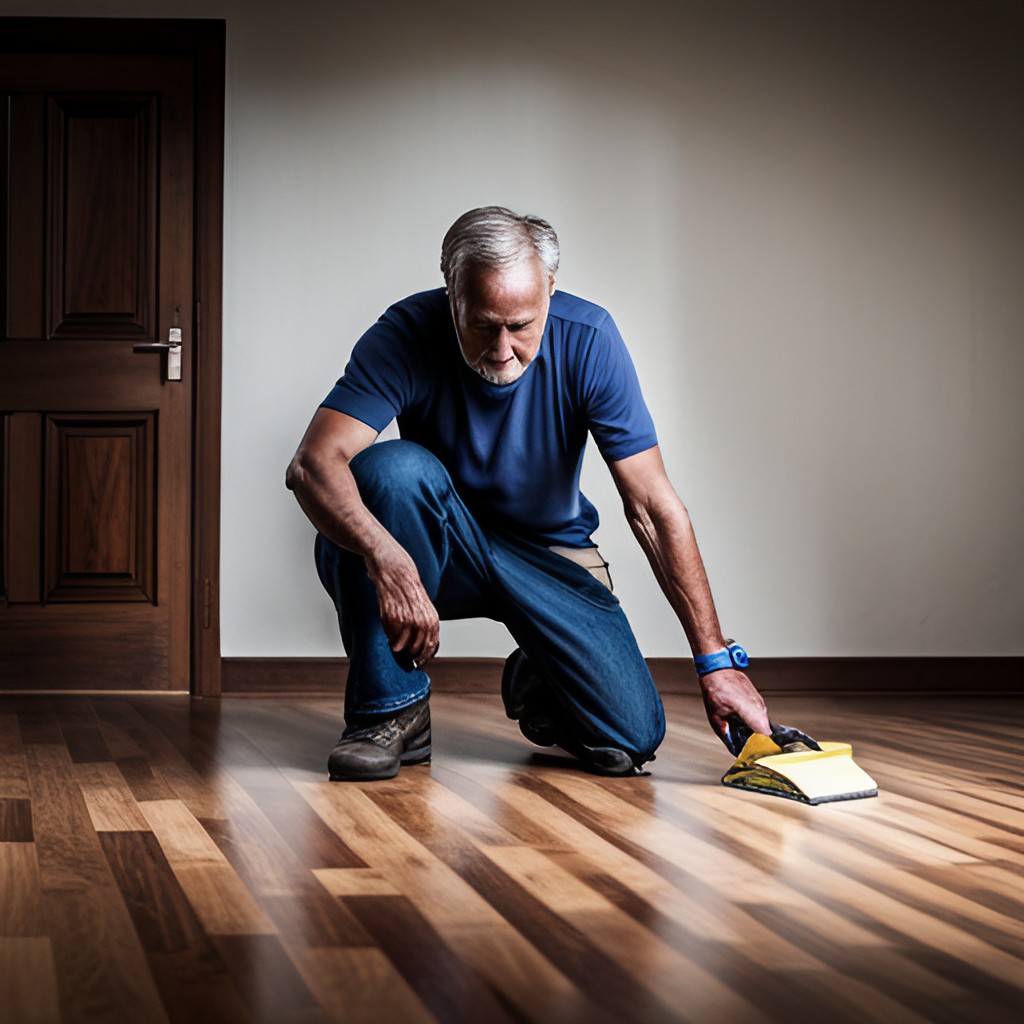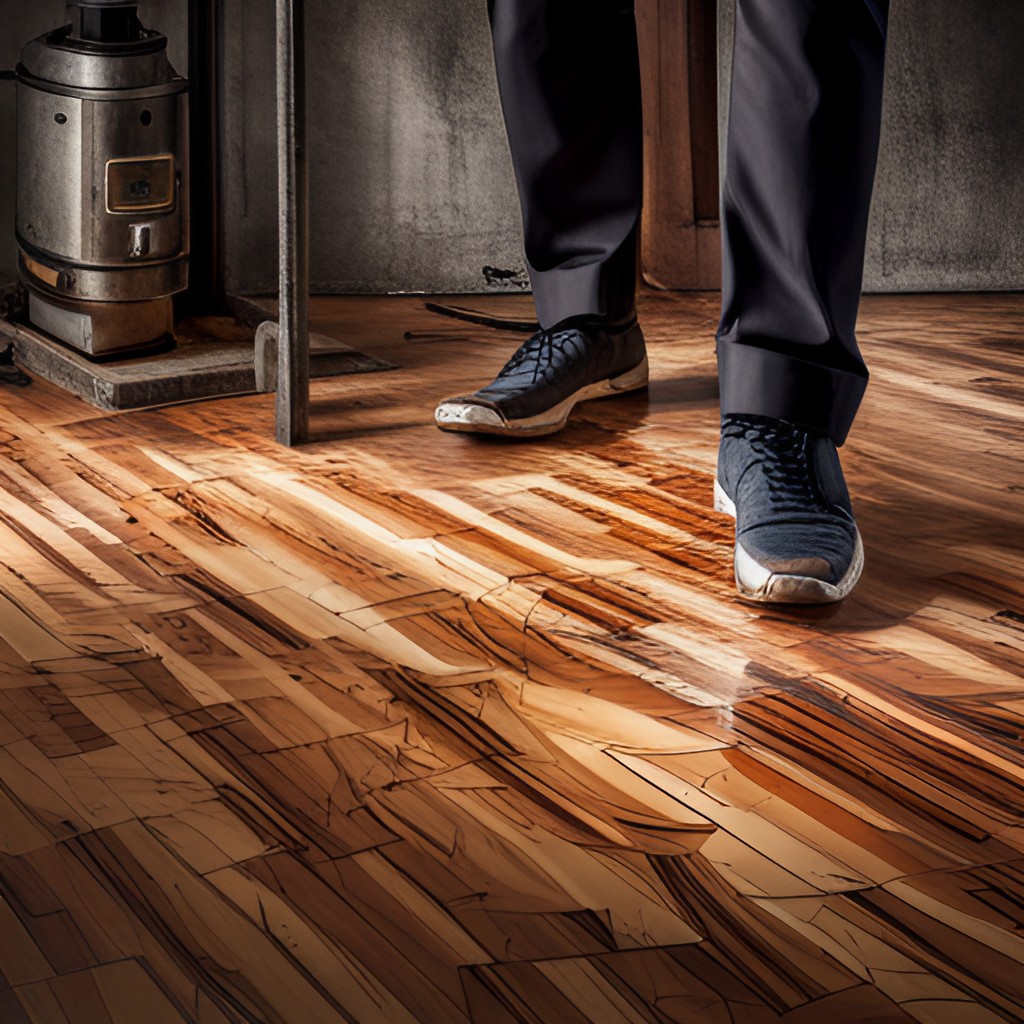Bamboo flooring has surged in popularity due to its eco-friendly nature, distinctive appearance, and durability. Known for its quick regrowth, bamboo is a sustainable choice for those looking to add a touch of natural elegance to their homes.
Despite its sturdy constitution, bamboo flooring is not impervious to the everyday wear and tear that comes with bustling household activities. Scratches, whether from pet claws, furniture movements, or high-heeled shoes, can mar its surface, diminishing the flooring’s aesthetic appeal.
Maintaining bamboo flooring by addressing these scratches promptly is crucial to preserve its beauty and ensure its longevity.
This not only helps in keeping the floor looking pristine but also in safeguarding your investment by extending the life of the flooring.
Preparation for Scratch Removal
Cleaning the Area

Before attempting to remove scratches from bamboo flooring, it is imperative to clean the scratched area thoroughly. This step is crucial for ensuring that the scratch repair process is effective.
Begin by sweeping the floor with a soft-bristle broom or using a vacuum cleaner with a hardwood floor attachment to remove any loose dirt or dust. It is important to avoid using a vacuum with a beater bar, as this can cause additional scratches.
Following the initial sweep, take a microfiber mop lightly dampened with a cleaner specifically designed for hardwood or bamboo floors to gently clean the area. Avoid using excessive water or harsh cleaning chemicals, as these can damage the flooring further.
This meticulous cleaning ensures that the scratch repair materials adhere properly and blend seamlessly with the surrounding area, achieving a more polished and consistent finish
Evaluating Scratch Depth
Before proceeding with scratch removal, it’s essential to assess the depth of the scratches on your bamboo flooring. This evaluation will determine the most appropriate removal method.
Scratches can be categorized into light surface scratches, which only affect the finish of the floor, and deep scratches that penetrate into the bamboo itself. Light scratches can often be treated with a simple refinishing product or a touch-up marker designed for bamboo flooring.
However, deeper scratches may require more intensive treatments such as sanding and resealing the affected area. To determine the depth, run your fingernail gently over the scratch.
If your nail doesn’t catch, it’s likely a surface scratch; if it does, you’re dealing with a deeper scratch. Choosing the correct approach based on scratch depth is crucial for restoring your flooring effectively without causing further damage
Methods for Removing Shallow Scratches
Applying Bamboo Floor Scratch Filler

Choosing the correct color match for your bamboo floor scratch filler is vital to ensure the repair blends invisibly with the existing flooring. Start by examining the color variation throughout your bamboo flooring, as natural bamboo can range from light to dark shades.
Manufacturers often offer a range of color-matched fillers. If possible, purchase a small amount of several shades that closely match your flooring.
Test these shades in an inconspicuous area or on a spare piece of bamboo flooring to find the best match. Once the right shade is selected, you’re ready to proceed with the application.
Step-by-Step Application Guide
Prepare the Area:
Clean the scratch and surrounding area using a microfiber cloth slightly dampened with a mild cleaner. Ensure the area is dry before proceeding.
Test the Filler:
Before applying the filler across the scratch, test it on a small, inconspicuous area to ensure it provides a close match to your floor’s color.
Apply the Filler:
Using a plastic putty knife, apply the bamboo floor scratch filler to the scratch. Be gentle to avoid putting excess filler on the undamaged flooring.
Remove Excess Filler:
Immediately wipe away any excess filler with a clean, dry cloth. This helps prevent any residue from drying on the surface of the bamboo, which could highlight the repair.
Allow to Dry:
Refer to the filler’s instructions for drying times. Avoid walking on or touching the area until it has fully dried.
Buff the Area:
Once dry, if the surface of the filler feels raised above the floor level, gently buff it with fine-grade sandpaper until it is flush with the surrounding floor.
Using the right color match and following these steps carefully will help ensure your bamboo flooring’s appearance is restored as seamlessly as possible.
Gentle Sanding Technique

For minor scratches that don’t fully penetrate the finish of the bamboo flooring, using fine steel wool or fine-grade sandpaper can be an effective way to blend the scratch into the surrounding area. When using either, it’s crucial to sand in the direction of the grain to prevent further damage.
Apply only light pressure to avoid deepening the scratch or damaging the finish. This gentle sanding technique is particularly useful when preparing the scratch for refinishing or re-staining.
Tips for Applying Matching Stain
After sanding, you may find the need to reapply a stain to match the original finish. Select a stain that closely matches your bamboo flooring.
Test the stain on an inconspicuous area or spare piece of flooring to ensure a match. Apply the stain with a small brush, following the grain of the wood.
Wipe away excess stains with a clean cloth to avoid uneven color. Allow the stain to dry thoroughly, according to the manufacturer’s instructions, before walking on the floor or replacing furniture.
Fixing Deep Scratches or Gouges
Deep Repair

Deep scratches or gouges in bamboo flooring go beyond the surface finish, reaching into the bamboo itself. These types of damage require more than just sanding and staining to fix. Begin by cleaning the area thoroughly to remove any debris.
If necessary, use wood filler that matches the color of your bamboo flooring to fill the gouge. Apply the filler with a putty knife, pressing it firmly into the scratch or gouge, and then smooth it out to ensure it’s level with the flooring surface.
Follow the wood filler’s instructions for drying times. Once dry, sand the filled area gently with fine-grade sandpaper until it is flush with the floor. If the color of the filled area does not perfectly match, you may need to apply a matching stain.
Test the stain on an inconspicuous area first to ensure a good match. Finish by applying a sealant over the repaired area to protect the bamboo and maintain a uniform finish across your flooring
Wood Putty Application
When addressing minor imperfections in bamboo floors, such as small scratches or dents, selecting the right wood putty is critical. It’s essential to choose a wood putty that is specifically compatible with bamboo flooring to ensure it adheres properly and blends seamlessly with the existing floor.
Start by selecting a putty color that closely matches your flooring. Preparation begins with a clean, dry surface, free of dust and debris. Apply the wood putty using a putty knife, pressing it firmly into the imperfection.
Be meticulous in your application, ensuring it is smooth and level with the surrounding area. Allow the putty to dry according to the manufacturer’s recommendations before proceeding to sand it down gently.
This should be done with fine-grit sandpaper to avoid additional scratches, achieving a smooth, flush finish.
If necessary, touch up the repaired area with matching bamboo flooring stain to conceal the repair, followed by a protective sealant to ensure durability and consistency in appearance across your floor.
Related Topics:
Professional Refinishing

When to Seek Professional Help
For bamboo floors that have suffered significant damage, such as deep scratches, water damage, or widespread discoloration, it’s advisable to consider professional refinishing. This level of damage often requires comprehensive sanding, staining, and sealing processes that go beyond simple DIY repairs.
Professional refinishing is also recommended in cases where the bamboo flooring has been previously refinished multiple times or if there is uncertainty about the type of finish used on the floor.
Engaging professionals ensures that the floor is restored correctly and safely, adhering to industry standards.
Overview of the Professional Refinishing Process
The refinishing process conducted by professionals typically involves several detailed steps, executed with precision:
Inspection and Assessment:
Professionals start by assessing the extent of damage to determine the best course of action. This phase includes checking for structural issues, and moisture levels, and identifying the type of finish currently on the floor.
Preparation:
The area is prepared by removing furniture, ensuring the room is clean, and set up with the necessary ventilation. All nail heads or splinters are dealt with to ensure a smooth surface for sanding.
Sanding:
Using commercial-grade sanding equipment, professionals meticulously remove the old finish layer, exposing the raw bamboo beneath. This step is crucial for eliminating deep scratches, and stains, and evening out the floor surface.
Staining:
If a color change is desired, or to match the original hue, a stain compatible with bamboo flooring is applied. This requires expertise to ensure even application and proper penetration into the bamboo.
Sealing:
The final step involves applying a high-quality sealant that provides protection against wear and tear, moisture, and scratching. Experts might apply multiple coats, sanding lightly between each coat, to achieve a durable and attractive finish.
By entrusting your bamboo flooring to skilled professionals, you guarantee a thorough restoration that extends the life of your floors and enhances the overall aesthetic appeal of your space.
Preventative Maintenance
Regular maintenance is essential to preserve the integrity and appearance of bamboo flooring. By implementing preventative measures, you can significantly reduce the risk of scratches and extend the lifespan of the flooring.
Here are some crucial tips and recommended products for cleaning and protecting bamboo floors:
Utilize Protective Pads:
Attach felt pads to the bottom of furniture legs to prevent scratching when the furniture is moved. Replace these pads regularly to ensure effectiveness.
Implement Area Rugs:
Strategically place area rugs in high-traffic zones, such as entryways and hallways, to minimize direct contact with footwear that can cause wear and tear.
Maintain a Clean Surface:
Regular sweeping, dust mopping, or vacuuming with a hardwood floor attachment can remove debris that may scratch the floor surface. Avoid using vacuums with beater bars as they can damage the finish of the bamboo flooring.
Immediate Spill Cleanup:
Promptly clean spills with a dry or slightly damp cloth to prevent water damage. Bamboo floors are sensitive to moisture, and prolonged exposure can cause warping or discoloration.
Use Appropriate Cleaners:
Opt for pH-neutral, non-abrasive floor cleaners specifically designed for hardwood or bamboo flooring. Avoid wax-based cleaners and those containing ammonia or bleach as they can dull the finish or damage the bamboo.
Recommended Products:
Bona Hardwood Floor Cleaner Spray: A safe and effective cleaner for bamboo floors, leaving no residue.
Murphy® Oil Soap Wood Cleaner: Ideal for deep cleaning, this product is gentle on bamboo floors and enhances their natural beauty.
By following these preventative maintenance tips and using recommended cleaning products, you can protect your bamboo flooring from premature wear, maintain its aesthetic appeal, and ensure its durability for years to come.
Conclusion
In conclusion, the key to removing scratches from bamboo flooring lies in detailed preparation, accurate assessment of the scratch’s depth, careful selection of repair methods, and the meticulous application of restoration techniques.
For shallow scratches, employing bamboo floor scratch filler or a gentle sanding technique followed by matching stain application can effectively blend the repair with the surrounding floor.
Deep scratches or gouges require a more robust approach, including the use of wood filler or putty, sanding, staining, and sealing to restore the floor’s integrity and appearance.
In cases of extensive damage, seeking professional refinishing services ensures a comprehensive restoration of the flooring. Furthermore, adopting a regimen of regular preventative maintenance, utilizing protective measures, and employing proper cleaning methodologies will safeguard the flooring from future damage.
By adhering to these instructive guidelines, homeowners can preserve the natural elegance and longevity of their bamboo flooring, maintaining its functionality and beauty for years to come.
FAQs
Can household items be used to repair minor scratches on bamboo flooring?
While specific products are formulated for bamboo floor repair, household items such as mayonnaise or olive oil are sometimes mentioned as DIY remedies. However, it’s crucial to approach these methods with caution. Such substances can temporarily mask the appearance of scratches but won’t effectively repair the damage.
For lasting results, it’s advisable to use products specifically designed for bamboo flooring, such as bamboo floor scratch filler or a repair kit that matches the floor’s finish.
How often should bamboo floors be refinished?
The frequency of refinishing bamboo flooring depends on several factors, including the level of foot traffic, the presence of pets, and overall wear and tear. Typically, bamboo floors might need refinishing every 7 to 10 years.
However, with diligent maintenance and care, including regular cleaning with appropriate products and protective measures like felt pads under furniture, the need for refinishing can be significantly reduced.
Are bamboo floors more prone to scratching than other hardwood floors?
Bamboo flooring is known for its durability and strength, often comparable to or exceeding that of traditional hardwood floors. However, like all wood flooring, it is susceptible to scratches, especially from hard, sharp objects, high heels, and pet claws.
The scratch resistance of bamboo floors can vary depending on the type of bamboo (e.g., strand-woven being the hardest), the finishing process, and the quality of the manufacturing. Regular maintenance and using protective measures can help mitigate scratching and maintain the floor’s beauty over time.
